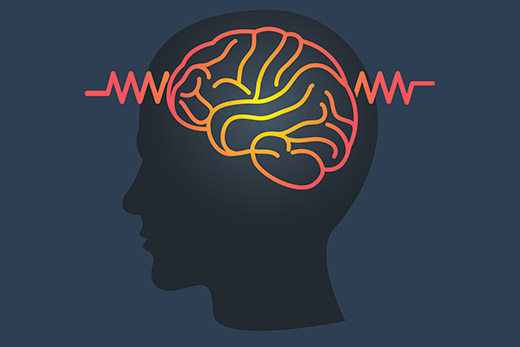Patients suffering from severe, treatment-resistant depression can experience long-term relief through deep brain stimulation, according to research conducted at Emory University.
A study published online Oct. 4 in The American Journal of Psychiatry found that deep brain stimulation (DBS) of a region of the brain called the subcallosal cingulate (SCC) provides a robust antidepressant effect that is sustained over a long period of time in the most severely depressed patients who have not responded to other treatments.
The long-term data presented in this study, conducted at Emory and led by Helen S. Mayberg, MD, now a professor at the Icahn School of Medicine at Mount Sinai, validates earlier work conducted by the research team and lays the foundation for additional studies to refine and optimize DBS for treatment-resistant depression patients. Andrea Crowell, MD, and Patricio Riva-Posse, MD, of Emory University School of Medicine served as co-authors on the study.
Deep brain stimulation — currently approved by the U.S. Food and Drug Administration to treat essential tremor, Parkinson’s disease, epilepsy and obsessive-compulsive disorder — is a neurosurgical procedure involving the placement of a neurostimulator (sometimes referred to as a “brain pacemaker”), which sends high-frequency electrical impulses through implanted electrodes deep in the brain to specific brain areas responsible for the symptoms of each disorder.
Mayberg led the first trial of DBS of the subcallosal cingulate white matter, known as Brodmann Area 25, for treatment resistant depression patients in 2005, demonstrating that it could have clinical benefit. Subsequent small, open-label trials produced similarly favorable results, yet despite these encouraging open-label results, a multi-center, randomized trial was halted early due to a lack of statistically significant antidepressant response at the designated, six-month a priori time point.
“Despite the fact that larger trials were halted early, what my colleagues and I were seeing as we continued to follow patients from our initial trials was that over time, they were getting better and not only that, they were staying better. So we stayed the course,” says Mayberg.
“Over eight years of observation, most of our study participants experienced an antidepressant response to the deep brain stimulation of Area 25 that was robust and sustained. Given that patients with TRD are highly susceptible to recurrent depressive episodes, the ability of DBS to support long-term maintenance of an antidepressant response and prevention of relapse is a treatment advance that can mean the difference between getting on with your life or always looking over your shoulder for your next debilitating depressive episode.”
Specifically, the study documents the long-term outcome data (four to eight years) for 28 patients who were enrolled in an open-label clinical trial of SCC DBS for treatment-resistant depression. Response and remission rates were maintained at or above 50 percent and 30 percent, respectively, through years two through eight of the follow-up period.
Three quarters of all participants met the treatment response criterion for more than half of their participation in the study, with 21 percent of all participants demonstrating continuous response to treatment from the first year forward. Of 28 participants, 14 completed at least eight years of follow-up, 11 completed at least four years, and three dropped out prior to eight years of participation. Data presented through this study support the long-term safety and sustained efficacy of SCC DBS for treatment resistant depression.
“While clinical trials generally are structured to compare active and placebo treatments over the short term our research results suggest that the most important strength of DBS in this hard-to-treat clinical population lies in its sustained effects over the long term,” says first author Andrea Crowell, MD, assistant professor of psychiatry and behavioral health sciences at Emory.
“For people suffering from inescapable depression, the possibility that DBS can lead to significant and sustained improvement in depressive symptoms over several years will be welcome news.
All study participants met criteria for either major depressive disorder or bipolar disorder type 2 and were in a current depressive episode of at least 12 months duration with non-response to at least four antidepressant treatments, psychotherapy and electroconvulsive therapy.
All study participants underwent SCC DBS surgery at Emory with the same surgeon, Emory neurosurgeon Robert E. Gross, MD, PhD, and received the same device. The first 17 participants were implanted between 2007 and 2009 in an open-label trial with a one-month, single-blind, stimulation off, lead-in period. An additional 11 participants with MDD were implanted utilizing tractography-guided anatomical targeting between 2011 and 2013.
A total of 178 patient years of data were collected and combined for analysis in this long-term follow up study. Participants were seen by a study psychiatrist weekly for 32 weeks, starting at least four weeks prior to surgery. Visits were then tapered to every six months for years two through eight of the study. Currently, 23 patients continue in long-term follow-up.
Research into the clinical and physiologic effects of deep brain stimulation for treatment resistant depression is continuing at both institutions, with active collaboration between the research teams.
This study was supported by the Hope for Depression Research Foundation, the Dana Foundation, the Stanley Medical Research Foundation and the Woodruff Fund with research DBS devices donated by St Jude Medical Neuromodulation (now Abbott Labs), under an FDA-registered, physician-sponsored investigational device exemption.

